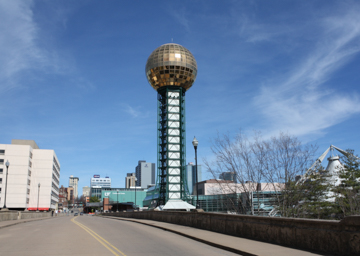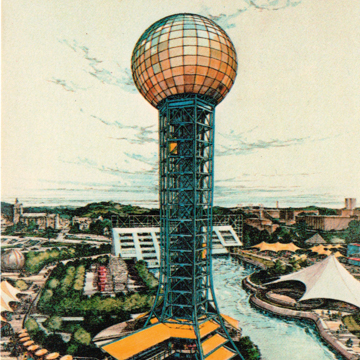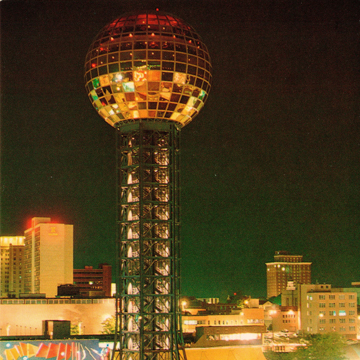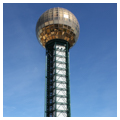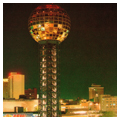The Sunsphere is a 266-foot-tall High-Tech observation tower that served as the centerpiece of the 1982 World’s Fair held in downtown Knoxville. Officially called the Knoxville International Energy Exposition, the theme of the 1982 Knoxville World’s Fair was “Energy Turns the World” and the Sunsphere represented “A Monument to the Sun, Source of All Energy.”
Featuring a gold-colored glass sphere supported by a hexagonal steel truss tower, the iconic structure currently houses a public observation deck, lounge, and private event spaces. Believed to be the first climate-controlled spherical building in the world, the Sunsphere has a patented structural design that was heralded in several engineering publications. Knoxville’s Sunsphere followed the tradition of iconic World’s Fair observation towers, including the 1889 Eiffel Tower in Paris, 1962 Space Needle in Seattle, and the 1968 HemisFair Tower in San Antonio.
Community Tectonics, an architectural firm based in nearby Gatlinburg, received the commission in 1979. The firm’s founder, Hubert Bebb (1903–1984), had already designed several innovative architectural and engineering landmarks in Tennessee, including the Buckhorn Inn near Gatlinburg in 1937–1940; an addition to the Dwight and Kate Wade House at Sevierville in 1958; Clingman’s Dome Observation Tower in the Great Smoky Mountains National Park, completed in 1959; and the elevated concrete “Skymart” walkways in downtown Morristown from 1964–1968. Community Tectonics collaborated with Stanley D. Lindsey and Associates, a Nashville engineering firm founded in 1966. In the 1970s and 1980s, Lindsey’s firm became a leader in the field of computer-aided design (CAD), and engineers Socrates A. Ioannides and Jack H. Horner used early versions of CAD to design the Sunsphere.
The equivalent of a 25-story building, the Sunsphere was built near the center of the 67-acre fair site between January 1981 and the spring of 1982. The five-level, 74-foot-diameter sphere is supported by six double steel-truss columns that are 198 feet in height and splayed at the bottom to provide greater structural stability. The sphere’s reflective and insulated glass windowpanes are tinted with 24-karat gold dust and cut into seven different shapes. Manufactured in New Jersey, each of the 360 energy-efficient panes cost an average of $1,000 at the time of construction. The entire Sunsphere structure is estimated to weigh 600 tons. During the fair, the steel structure was painted blue to match the sky; it is currently painted green.
During the 1982 World’s Fair, fairgoers paid $2 to take one of three high-speed glass elevators to the Sunsphere’s two observation decks, VIP lounge, and full-service restaurant, which featured food items such as the “Sunburger” and a rum and fruit juice cocktail called the “Sunburst.” A Hardee’s fast-food restaurant was temporarily located in the base. From May 1 through October 31, 1982, an average of 60,000 daily visitors (10.8 million total) toured the Sunsphere. As the fair’s theme structure, the Sunsphere was featured on postcards, logos, and souvenirs.
The iconic Sunsphere still serves as the symbol of Knoxville in marketing and promotional materials. Its unique shape inspired the design of logos and mascots for local sports teams. The Sunsphere gained national notoriety in a 1996 episode of the animated comedy series The Simpsons, when Bart Simpson and his friends made a secret road trip to Knoxville and accidentally knocked over the Sunsphere. In 2000, nuclear war protesters scaled the tower, hung a banner stating, “Stop the Bombs,” and camped out for three days before surrendering to police.
The Sunsphere stood empty or under-utilized for most of its post-fair life, but in 2007–2008, the City of Knoxville renovated it for use as a public observation deck with special event rental facilities, a cafe, and an upscale lounge. In 2014, the observation deck was further renovated for use as a visitors’ center with interpretive panels and videos. The Sunsphere remains the centerpiece of the World’s Fair Park, which includes two other cultural facilities: the Tennessee Amphitheater, the only other structure remaining from the 1982 World’s Fair, and the more recent Knoxville Museum of Art.
References
American Institute of Architects. “Hubert Bebb” American Architects Directory. R.R. Bowker, 1956, 1962, 1970.
City of Knoxville. “World’s Fair Park: The Sunsphere.” Accessed June 14, 2015. http://www.worldsfairpark.org/worlds-fair-sunsphere.html.
City of Knoxville. “Knoxville Sunsphere.” Accessed June 14, 2015. http://www.sunsphere.info/.
Jones, Robbie D. The Historic Architecture of Sevier County, Tennessee. Sevierville, Tennessee: Smoky Mountain Historical Society, 1997.
Jones, Robbie D., “Dwight and Kate Wade House: New York World’s Fair House,” Sevierville, Sevier County, Tennessee. National Register of Historic Places Inventory ‐ Nomination Form, 1997. National Park Service, U.S. Department of the Interior, Washington, DC.
Knowles, Susan W. “Hubert Bebb.” In Tennessee Encyclopedia of History and Culture. Tennessee Encyclopedia of History and Culture. Tennessee Historical Society, 2002–2016. Published December 23, 2009. http://www.tennesseeencyclopedia.net/entry.php?rec=1557.
Miller, Theresa. “The Knoxville Sunsphere.” Princeton University, 2000. Accessed June 14, 2015. http://www.tntrivia.com/misc/sunspherehistory.pdf.
Shearer, John. “Sunsphere shines as city’s architectural icon,” Knoxville News-Sentinel, March 22, 2013.
Whitehead, Paul N. “World’s Fair Park main attraction reopened to public Thursday.” Knoxville News-Sentinel, July 6, 2007.
Woodward, Martha Rose. Knoxville's 1982 World’s Fair.Charleston, SC: Arcadia Publishing, 2009.



